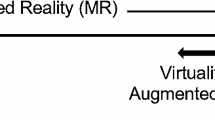Abstract
Immersive augmented reality, in practical terms, is a real-time, immersive processing experience which bind together elements of real life with the images presented. The study is a systematic literature review that aims to analyze the main methods and projects for the development of virtual learning environments (VLEs), especially in STEM disciplines, with immersive scenarios in the field of distance higher education. The analyzed scientific productions underwent revision on the search strings, which presented a high growth in the application of Virtual Reality, Augmented Reality, Mixed Reality and Extended Reality in education. The studies revealed that the use of Immersive Augmented Reality in education is able to increase students’ motivation and interest in studies, mainly due to the teaching and learning environment becoming more dynamic. Additionally, it enables students in the immersive environment to interact and achieve effective learning.
Access this chapter
Tax calculation will be finalised at checkout
Purchases are for personal use only
Similar content being viewed by others
References
Bookhamer, R.S.: STEM in Elementary School Education: Evaluating a STEM and Augmented Reality Professional Development Workshop for Educators. University of Pittsburgh (2022). http://d-scholarship.pitt.edu/43529/1/bookhamerRyan_etd.pdf
Reisoğlu, I., Topu, B., Yılmaz, R.: 3D virtual learning environments in education: a meta-review. Asia Pacific Educ. Rev. 18, 81–100 (2017). https://doi.org/10.1007/s12564-016-9467-0
Baceviciute, S.: Designing Virtual Reality for Learning. University of Copenhagen (2020). https://www.researchgate.net/publication/349313006
De-la-Torre-Ugarte-Guanilo, M.C., Takahashi, R.F., Bertolozzi, M.R.: Revisão sistemática: noções gerais. J. School Nurs. – Univ. São Paulo (2011). https://doi.org/10.1590/S0080-62342011000500033/
Dengel, A.: Effects of Immersion and Presence on Learning Outcomes in Immersive Educational Virtual Environments for Computer Science Education, University of Passau (2020). https://opus4.kobv.de/opus4-uni-passau/files/841/Dengel_Andreas_VirtualReality
Kitchenham, B., Charters, S.: Guidelines for performing systematic literature reviews in software engineering. Technical Report EBSE 2007-001, Keele University and Durham University Joint Report (2007). https://userpages.uni-koblenz.de/~laemmel/esecourse/slides/slr.pdf
Lacerda, D.P.: Design Science Research: research method for production engineering. Manag. Product. 20, 741–761 (2013). https://www.scielo.br/j/gp/a/3CZmL4JJxLmxCv6b3pnQ8pq
Morillo, D.: Assessment in 3D virtual worlds: QTI in Wonderland. In: Sánchez, J. (Ed.): Congreso Iberoamericano de Informática Educativa, vol. 1, pp. 410–417. Santiago de Chile (2010). http://www.tise.cl/volumen6/TISE2010/Documento60.pdf
Ijsselsteijn, W.A.: Presence in depth. Phd Thesis, Industrial Engineering and Innovation Sciences. Technische Universiteit Eindhoven (2004). https://doi.org/10.6100/IR581425
Acknowledgements
I would like to express my sincere gratitude to my advisors, Prof. Luciano Frontino de Medeiros and Prof. Manuel Gradin de Oliveira Gericota, for their continuous support, valuable guidance and constructive feedback. They inspired me to pursue academic excellence and to contribute to the advancement of knowledge in Immersive Learning. Special thanks to Prof. Gericota for the welcome and guidance of the international doctoral internship carried out at ISEP – Porto.
Author information
Authors and Affiliations
Corresponding author
Editor information
Editors and Affiliations
Rights and permissions
Copyright information
© 2024 The Author(s), under exclusive license to Springer Nature Switzerland AG
About this paper
Cite this paper
Guerra, A.R., de Medeiros, L.F., Gericota, M. (2024). A Review of Immersivity in Distance Higher Education STEM Subjects. In: Bourguet, ML., Krüger, J.M., Pedrosa, D., Dengel, A., Peña-Rios, A., Richter, J. (eds) Immersive Learning Research Network. iLRN 2023. Communications in Computer and Information Science, vol 1904. Springer, Cham. https://doi.org/10.1007/978-3-031-47328-9_39
Download citation
DOI: https://doi.org/10.1007/978-3-031-47328-9_39
Published:
Publisher Name: Springer, Cham
Print ISBN: 978-3-031-47327-2
Online ISBN: 978-3-031-47328-9
eBook Packages: Computer ScienceComputer Science (R0)




